
The Delta Cultural Center in downtown Helena, Arkansas, is a cultural center and museum of the Department of Arkansas Heritage. It is dedicated to preserving and interpreting the culture of the Arkansas Delta. They also partner with other cultural organizations to interepret different cultural elements.

The Old State House, formerly called the Arkansas State House, is the oldest surviving state capitol building west of the Mississippi River. It was the site of the secession convention, as well as the fourth constitutional convention when delegates agreed to ensure voting rights for freedmen and establish public education.
The Quapaw Quarter of Little Rock, Arkansas, is a section of the city including its oldest and most historic business and residential neighborhoods. The area's name was first given in 1961, honoring the Quapaw Indians who lived in the area centuries ago.

Hillcrest Historic District is an historic neighborhood in Little Rock, Arkansas that was listed on the National Register of Historic Places on December 18, 1990. It is often referred to as Hillcrest by the people who live there, although the district's boundaries actually encompass several neighborhood additions that were once part of the incorporated town of Pulaski Heights. The town of Pulaski Heights was annexed to the city of Little Rock in 1916. The Hillcrest Residents Association uses the tagline "Heart of Little Rock" because the area is located almost directly in the center of the city and was the first street car suburb in Little Rock and among the first of neighborhoods in Arkansas.

In the law regulating historic districts in the United States, a contributing property or contributing resource is any building, object, or structure which adds to the historical integrity or architectural qualities that make the historic district significant. Government agencies, at the state, national, and local level in the United States, have differing definitions of what constitutes a contributing property but there are common characteristics. Local laws often regulate the changes that can be made to contributing structures within designated historic districts. The first local ordinances dealing with the alteration of buildings within historic districts was passed in Charleston, South Carolina in 1931.
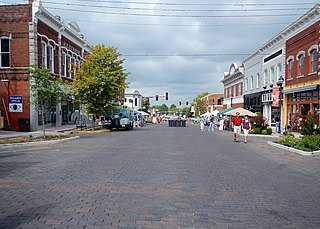
The Rogers Commercial Historic District, known informally as Historic Downtown Rogers, is a historic district in the central business district of Rogers, Arkansas. When it was first listed on the National Register of Historic Places in 1988, it was known as the Walnut Street Historic District; this was changed when the district was enlarged in 1993. The district encompasses a portion of the city's central business district, whose historical significance extends from about 1885 to the end of World War II.
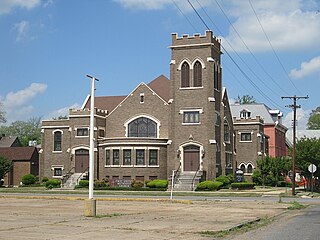
The Perry Street Historic District encompasses a fine collection of early-20th century architecture in Helena–West Helena, Arkansas. It includes fifteen buildings, arrayed on the single city blocks stretching south and west from the junction of Perry and Pecan Streets. The buildings on these blocks represent a cross-section of private and public architecture spanning 1880–1930, including two churches, the only synagogue in Phillips County, and the county's oldest public building, the 1879 Helena Library and Museum. Most of the residences in the district were built between 1900 and the 1920s. Although most of the residential architecture is Arts and Crafts in style, it includes two fine Queen Anne Victorians: the Moore House at 608 Perry and the William Nicholas Straub House at 531 Perry.

The Governor's Mansion Historic District is a historic district covering a large historic neighborhood of Little Rock, Arkansas. It was listed on the National Register of Historic Places in 1978 and its borders were increased in 1988 and again in 2002. The district is notable for the large number of well-preserved late 19th and early 20th-century houses, and includes a major cross-section of residential architecture designed by the noted Little Rock architect Charles L. Thompson. It is the oldest city neighborhood to retain its residential character.
The University of Arkansas Campus Historic District is a historic district that was listed on the National Register of Historic Places on September 23, 2009. The district covers the historic core of the University of Arkansas campus, including 25 buildings.

The Little Rock U.S. Post Office and Courthouse, also known as Old Post Office and Courthouse, in Little Rock, Arkansas, is a historic post office, federal office, and courthouse building located at Little Rock in Pulaski County, Arkansas. It is a courthouse for the United States District Court for the Eastern District of Arkansas.

The Fayetteville Historic Square, in Fayetteville, Arkansas, includes the original Fayetteville post office, the Old Bank of Fayetteville Building, the Lewis Brothers Building, the Mrs. Young Building, and the Guisinger Building. These buildings are listed in the National Register of Historic Places. There are several more recent buildings located on the Square.

The Lee County Courthouse features two courthouse buildings constructed at 15 East Chestnut Street in Marianna, Arkansas, United States, the county seat of Lee County. The original courthouse was a wooden at the corner of Poplar and Mississippi streets built in 1873 when Marianna became the county seat of Lee County. A larger courthouse was built in 1890 and it was expanded with another new courthouse building added next to it in 1936. The courthouse compound was listed on the National Register of Historic Places in 1995. The newer courthouse was designed by Memphis, Tennessee based architect George Mahan Jr. with Everett Woods and built in the Colonial Revival and Art Deco styles.

The Arkansas City High School was a comprehensive public high school serving students between 1910 and 2004 in Arkansas City, Arkansas, United States. Since 2005, the original 1910 building, which is listed on the National Register of Historic Places, has served as an annex of the neighboring Desha County Courthouse.

Washington–Willow Historic District is a residential neighborhood of Fayetteville, Arkansas containing over one hundred historically and architecturally significant homes. Styles range from those popular in the mid-19th century through present day, predominantly Victorian, Italianate, neoclassical, and craftsman bungalows. Historically, Fayetteville leaders in business, law and education have all called the district home. The homes sit at the foot of East Mountain within the Masonic Addition, the first addition platted following incorporation.
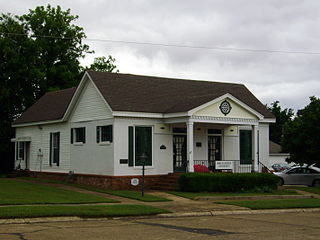
The Flanagin Law Office is a historic office building at 320 Clay Street in Arkadelphia, Arkansas. The front brick portion of the building was built in 1858 for J. L. Witherspoon, a local attorney, who later became Attorney General of Arkansas and sat on the state's high court. Witherspoon took on Harris Flanagin as a partner; Flanagin served as Governor of Arkansas during the American Civil War, and used this building as a law office for many years. Flanagin's son had the wood-frame rear section added, converting the building into a residence. It has since been converted back to a law office.

The DeWitt Post Office in DeWitt, Arkansas is a historic post office building at 221 West Cross Street. It is a modest single-story brick and masonry structure with a hip roof, built in 1939 in a restrained Colonial Revival style. It is basically rectangular structure, with a loading dock area projecting from the center of the rear. The building is notable for the murals in its lobby area, painted by William Traher of Denver, Colorado, and paid for with funds from the United States Treasury Department's Section of Fine Arts, a Depression-era project to support artists.

The Moore-Jacobs House is a historic house at 500 North Main Street in Clarendon, Arkansas. It is a single-story wood-frame structure, with a side-gable roof and an projecting entry pavilion with a pedimented gable supported by paired square columns. Built in about 1870, this Greek Revival house is a testament to that style's enduring popularity in Arkansas. It was moved across the street from its original location in 1931. It was also for many years home to Margaret Moore-Jacobs, known for her inspirational writings.
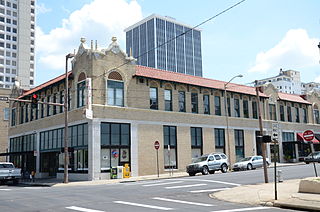
The Moore Building is a historic commercial building at 519-23 Center Street in Little Rock, Arkansas. It is a two-story brick building with Mission Revival styling, designed by Thompson, Sanders & Ginocchio and built in 1929. It has an orange tile parapet roof, with parapetted corners, and periodic use of decorative tiles and terra cotta panels on its two street-facing facades.

The Dan Stowers Office Building is a historic commercial building at 1516 West 3rd Street in Little Rock, Arkansas. It is a single-story masonry structure, with an International style design by architect Dan Stowers, Sr. It was built in 1961, and served as the office of Stowers and his son, Dan Jr., until 2013. The building is notable for its Mid-Century Modern design, featuring curtain-wall windows, porcelain enamel panels, and blocks of haydite in its construction.
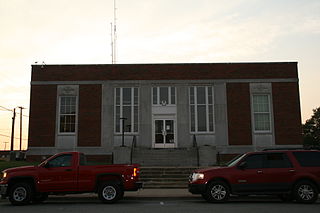
The former Morrilton Post Office is a historic post office building at 117 North Division Street in downtown Morrilton, Arkansas. It is a single-story masonry structure, built of brick and limestone in a simplified Art Deco style. Its facade is divided into five bays, the outer two separated by brick piers from the inner three. The inner three are articulated by limestone pilasters, and feature large multipane windows and the main entrance. The interior features a mural entitled "Men at Rest" by Richard Sargent, painted in the 1930s as part of a federal works project.




















